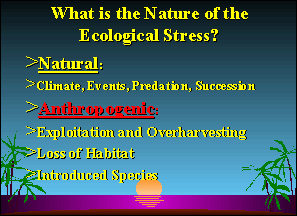 | ||||||
| Articles | Projects | Resume | Cartoons | Windsurfing | Paintings | Album |
Biodiversity:
Ecological Effects of Species Introductions and Extinctions
by Waterose et. al.


An Ecological Stressor:
is "any physical, chemical, or biological constraint that limits the productivity of the ecosystem and causes measurable ecological detriment or change". There are different levels of complex reactions to stress. These include changes in energetics or respiration, nutrient cycling, and the structure of the community (Freedman, 1995).Ecological Stressors can be natural, or anthropogenic. Some examples of natural stressors include changes in climate such as the series of cold glacials and warm interglacials. A significant event can alter the composition of biodiversity; 245 million years ago 96 percent of the existing species became extinctand new species evolved. A more familiar period occured 65 million years ago when the Dinosauria and 76 percent of the existing species became extinct. A volcanic eruptions may also be considered a significant event that alters biodiversity. Other natural stressors include predation and succession amongst species (Freedman, 1995).
Anthropogenic activities have the most impact on altering biodiversity. These activities include: unsustainable exploitation and overharvesting, destruction of habitat, and the introduction of aliens. They’re out there!
The effects of introduced species can be beneficial or negative or both. About 15 percent of exotics on Vancouver Island are perceived as problem species. Negative impacts include the introduction of predators, competitors, and disease: all of which can wipe out native populations. Islands are particularly vulnerable to the introduction of predatorial exotics. An introduced species can oppupy a niche and compete with native species for food and space. Furthermore, initially there is usually no natural predator species to control the introduced species. Beneficial effects are the introduction of commercially harvested species such as the Manilla clams, Japanese Oysters, and some scallops and mussels (Jamieson, 1997).



 email Waterose
email Waterose
Please Sign My Guestbook
Please View My Guestbook

| Articles | Projects | Resume | Cartoons | Windsurfing | Paintings | Album |
 | ||||||